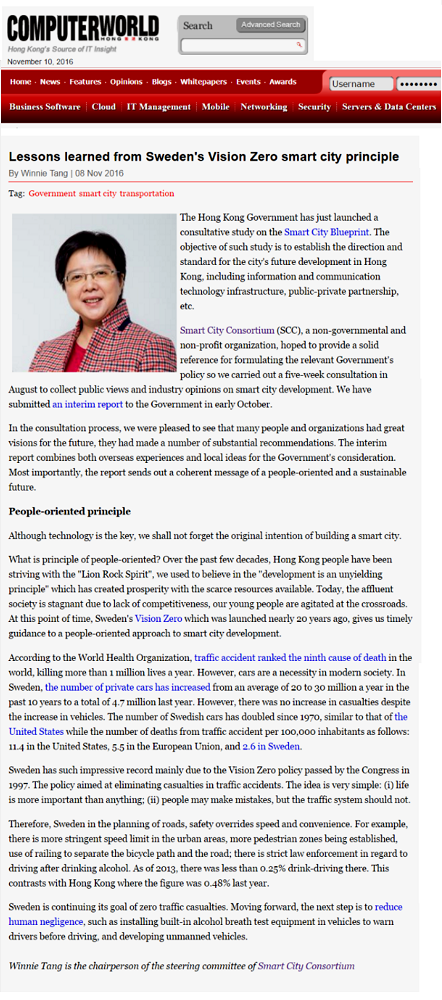網上版請按此

Lessons learned from Sweden's Vision Zero smart city principle
Smart City Blueprint. The objective of such study is to establish the direction and standard for the city's future development in Hong Kong, including information and communication technology infrastructure, public-private partnership, etc.
Smart City Consortium (SCC), a non-governmental and non-profit organization, hoped to provide a solid reference for formulating the relevant Government's policy so we carried out a five-week consultation in August to collect public views and industry opinions on smart city development. We have submitted an interim report to the Government in early October.
In the consultation process, we were pleased to see that many people and organizations had great visions for the future, they had made a number of substantial recommendations. The interim report combines both overseas experiences and local ideas for the Government's consideration. Most importantly, the report sends out a coherent message of a people-oriented and a sustainable future.
People-oriented principle
Although technology is the key, we shall not forget the original intention of building a smart city.
What is principle of people-oriented? Over the past few decades, Hong Kong people have been striving with the "Lion Rock Spirit", we used to believe in the "development is an unyielding principle" which has created prosperity with the scarce resources available. Today, the affluent society is stagnant due to lack of competitiveness, our young people are agitated at the crossroads. At this point of time, Sweden's Vision Zero which was launched nearly 20 years ago, gives us timely guidance to a people-oriented approach to smart city development.
According to the World Health Organization, traffic accident ranked the ninth cause of death in the world, killing more than 1 million lives a year. However, cars are a necessity in modern society. In Sweden, the number of private cars has increased from an average of 20 to 30 million a year in the past 10 years to a total of 4.7 million last year. However, there was no increase in casualties despite the increase in vehicles. The number of Swedish cars has doubled since 1970, similar to that of the United States while the number of deaths from traffic accident per 100,000 inhabitants as follows: 11.4 in the United States, 5.5 in the European Union, and 2.6 in Sweden.
Sweden has such impressive record mainly due to the Vision Zero policy passed by the Congress in 1997. The policy aimed at eliminating casualties in traffic accidents. The idea is very simple: (i) life is more important than anything; (ii) people may make mistakes, but the traffic system should not.
Therefore, Sweden in the planning of roads, safety overrides speed and convenience. For example, there is more stringent speed limit in the urban areas, more pedestrian zones being established, use of railing to separate the bicycle path and the road; there is strict law enforcement in regard to driving after drinking alcohol. As of 2013, there was less than 0.25% drink-driving there. This contrasts with Hong Kong where the figure was 0.48% last year.
Sweden is continuing its goal of zero traffic casualties. Moving forward, the next step is to reduce human negligence, such as installing built-in alcohol breath test equipment in vehicles to warn drivers before driving, and developing unmanned vehicles.
Dr. Winnie Tang
Chairman of the Steering Committee of Smart City Consortium